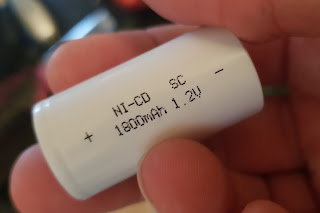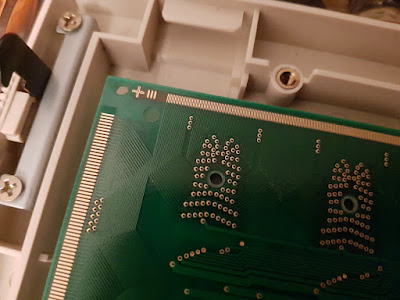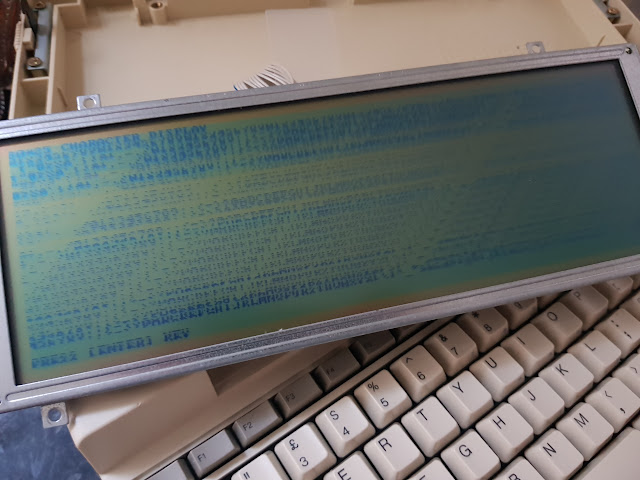Intro
Part one details the history of this computer more extensively.
Part two (written first, oddly) shows in-depth the steps required to restore a non-working machine to full health.
Part three is an attempt at a definitive technical run-down.
 |
| The Toshiba T1000 in the state I received it. |
Background
Teardown
Step One: Top Case
The first step was classically simple: flip the laptop over and remove 6 screws from the underside securing the top and bottom case together. Once they have come out, there are a couple of clips on the left-hand side (where there isn't a screw holding the case together).

Once these have been removed, the top case comes away and can rotate to the left, so it lies alongside to the base (see above). The top case is connected to the logic board via a grey ribbon cable, which pops out of its connector. The lid can then be placed elsewhere.
Step Two: Keyboard
There are two screws (circled) holding the keyboard into the chassis. Simply unscrew these, and lift the keyboard towards you. If you haven't already, remove the ribbon cable and put the keyboard to one side.
Step Three: Battery
You don't need to remove the screw you can see, as this merely secures the metal plate to the plastic. Be aware of any battery leakage at this point.
Step Four: Floppy Drive
The floppy drive is secured via three screws: one at the rear and two securing it to the base.
Note that the two going into the base are longer than the others. Once these are removed, the ribbon cable can be unplugged (it pulls loose like any other floppy interface) and the drive can be rotated to the right where it unclips from the base.
Step Five: Motherboard
You will now be left with just the base and the motherboard. Unplug the speaker wire and remove the 4 screws indicated. The board can then be removed, but it will require a bit of a jiggle as the ports on the rear and the contrast dial poke through the case and hold it in place slightly.
Note that my battery is still attached at this point. That's because I took the photo when I was reassembling, and the battery is soldered to the connector. More on that later.
Repair
Motherboard
Or logic board, whatever. The one in my unit was looking pretty good for a 30+ year old piece of kit. I wasn't even in double figures when this thing came out. If you're unlucky, the internal battery will have corroded and perhaps messed up all manner of things. Whether or not you are able to resolve these issues is between you and your bath of vinegar. I will be focusing on replacing the capacitors that tend to fail, most of them being in the power supply circuitry.
|
|
|
|
Battery
If the battery needs to be replaced, finding a modern replacement will be next-to-impossible, but running the T1000 without one won't be possible (unless you feed 4.8 volts directly to the battery terminals, but then it wont be portable). If you don't have the battery's caddy, or choose to discard it, you could attach an equivalent replacement that doesn't perfectly match the original. This article will cover constructing a replica of the original.
Thanks to Formulator for providing the above photo in this thread on the Vintage Computer Forums. He was able to construct a replica that used the original wires and connector. My effort was a little more bodged. For now.

First I purchased the batteries, ordering more than necessary should I mess something up. Any SubC / Csub / SC / CS size battery that is NiCD / Ni-CD / Ni Cad and 1.2V will be suitable, and you can also decide on the charge. I went with 1800mAh - neither excessively high nor low - and they should definitely have tags for soldering them together.

First I purchased the batteries, ordering more than necessary should I mess something up. Any SubC / Csub / SC / CS size battery that is NiCD / Ni-CD / Ni Cad and 1.2V will be suitable, and you can also decide on the charge. I went with 1800mAh - neither excessively high nor low - and they should definitely have tags for soldering them together.
I didn't get all the photos I wanted of the construction process yet, but I essentially soldered them side-to-side in serial (positive to negative). I then reclaimed some good red- and black-insulated copper wires from an expired PC power supply's Molex connector and soldered these to either end of the battery pack. If you really want you can solder the wires in pairs like the original, and this will be necessary if you are using a connector (both wires being connected constitutes the laptop's 'battery detection' mechanism). I made the negative wire longer so that it, and the positive lead, would be the same length at the positive end. I then used duct tape to hold it all together. Fitted in the cradle it looks like this:
 |
| The completed replica battery, installed in the cradle. I reckon I'll reconstruct it at some point. |
I didn't have the requisite female connector to connect it to the board, although I suspect it's a VH Series Wire-to-Board connector, which are easily obtained. Instead I soldered the wires directly to the pins on the header, using solder to bridge pins 1&2 for positive and 3&4 for negative.
Again, it's a bodge job but often this is appropriate while repairing and troubleshooting.
I had a dig through my mains adaptor box and found a suitable power supply. The original PSU was model PA7842U which, according to this photo. I've used a 9V, 2A model and this seems sufficient. It doesn't seem to drive the laptop when the battery is depleted but that could be the charging circuitry.
Once the battery had been left to charge for a while, I attempted to turn the laptop on. Initially I got nothing on the display at all, but the power light illuminated green and, after a few seconds, there was a beep and the floppy drive growled. I tried this a few more times without success. Fortunately the T1000 has a composite connector, and an RGB D-sub so I got my Commodore 1084-D monitor out. Still no picture. There are no labels on the keyboard that indicate a function to enable an external display. However, in the process of fiddling about, I happened to leave the laptop on for a while - impatience is something that only inhibits the troubleshooting process. After about 30 seconds, text began to appear on the screen, until the entire screen eventually went black. I adjusted the contrast and had a command prompt!
With no BIOS battery present, the T1000 relies on the main battery to remember the settings such as date and time. As noted elsewhere, The T1000 is Y2K compliant, which is more than can be said for my Acermate from 1992. The display continued to behave erratically, but I got on with some further 'testing' in the meantime.
Testing

Obviously it was necessary to ensure that some games worked. Tetris and Dangerous Dave got first honours and worked perfectly. The funny thing about most DOS games made up until about 1991/2 is that they maintained IBM PC compatibility. That means a 4.77MHz 8088 with less than 640KB RAM and 4 colour CGA graphics. Despite being introduced in 1987, it was only once affordable 386 system were adopted in homes that specs increased and VGA games really started to take off. So there are many games that this laptop can handle, a number of them classics.

There were many complaints at the time of its release that the screen on the T1000 was almost unviewable due to its lack of backlight and poor contrast. Can't say I've had any problems so far. And, with composite out, that also gives the option of colour!
 |
| Greg Kuperberg's PC-Man (1983) |
The floppy drive seemed to begin behaving erratically. The internal drive supports double-density disks (720K) and I was copied games onto pre-formatted disks (1.44MB high density disks with the hole taped over) but was getting sporadic read errors, specifically to do with sector 0 being unreadable. Enter Dave Dunfield's TESTFDC.
So it's a fussy floppy drive, but I eventually worked out that the USB floppy drive I was using on my Windows 7 PC to copy files was corrupting disks. So I binned it and got another one out. This seemed to have solved the problem.
Now some more utilities.
 |
| Readout from Norton's System Information. |
C&T's benchmark program confirms this by scoring the T1000 exactly the same as the IBM PC. But performance does not equal compatibility. One of the tests of IBM compatibility used extensively at the time the T1000 was released was being able to run Microsoft Flight Sim 1.0.
Subsequently there has been established a much more rigorous test - the ultimate, if you will: a demo called 8088MPH by Hornet + CRTC + DESiRE, which placed first at Revision 2015. The T1000 is not 100% IBM compatible, but it's near enough for most.
Display
I had a feeling that the LCD issues were capacitor related, as these tend to regulate the voltages being supplied here and there, plus capacitors are more likely to 'degrade' over time rather than outright fail like most components. Having changed all the key capacitors on the logic board, that only left me to disassemble the display, er, assembly.
 By peeling off the sticker on the facing edge of the hinge, the two screws that secure the display are accessible. Removing these allows the hinge to be separated into two pieces. There is enough flex in the display connector to then lift the lid clear. Next, the grey front panel needs to be removed from the LCD assembly, which is facilitated by removing the Toshiba sticker (carefully). This reveals a countersunk screw which, once removed, allows the grey fascia to be unclipped from the beige part. There was some gunk that had dripped into the hinge, making it very difficult to clean. Dismantling the hinge allowed me to clean this fully.
By peeling off the sticker on the facing edge of the hinge, the two screws that secure the display are accessible. Removing these allows the hinge to be separated into two pieces. There is enough flex in the display connector to then lift the lid clear. Next, the grey front panel needs to be removed from the LCD assembly, which is facilitated by removing the Toshiba sticker (carefully). This reveals a countersunk screw which, once removed, allows the grey fascia to be unclipped from the beige part. There was some gunk that had dripped into the hinge, making it very difficult to clean. Dismantling the hinge allowed me to clean this fully.This process reveals the LCD board, which is encased in a metal bracket with the LCD itself sandwiched between. The ribbon cable can be unplugged. As you can see, adjacent to the connector, there is a row of 7 electrolytic capacitors. Even though they look in good condition and probably haven't lived a particularly strenuous life, replacing them is mandatory to eliminate them as a possible problem.
In this photo they are the plastic strips running along each side of the LCD. And they're a pain in the arse. I remember these from back in the day when I used to dismantle calculators and the like. I guess they were novel at the time but, once I'd removed the PCB and replaced the capacitors, I didn't find them quite so novel.
Here is the rear of the controller PCB. The pitch of the contacts differs hugely between the horizontal and vertical contacts
When I reassembled the display and tested it, it was instantly more responsive and, while there wasn't much text on the screen, I didn't see a huge problem at first. But I knew all was not well. I ran the built-in diagnostics program, TEST10.COM, and filled the display with characters.
Fuck.
I then re-opened and closed the display assembly thinking it was purely a lack of pressure that was causing the problem.
Shit. And again:
Bollocks.
I was beginning to think I had completely ruined it. So I did some research and discovered that these connectors are extremely sensitive to dust. I got a few cotton buds (or q-tips, if you will) and a small dish of boiling water, then ran the damp buds along the face of the connectors. This is a great way to clean something, because:
a) there are no chemicals involved so no unexpected side effects,
b) the water vapourises quickly if you don't put too much on,
c) you can clearly see if gunk is being lifted from the surface being cleaned,
d) a dry bud can be used to absorb any possible residue left afterwards.
Success!! Sort of. But progress had been made - this was exciting. It seemed that cleaning the 'vertical' connector (pixels going down) had worked a treat. I did the same with the 'horizontal' connector and...
Bingo!! I breathed a huge sigh of relief.
Keyboard
Some of the keys were behaving intermittently so I took the keyboard apart. This was a lot simpler than some of the other procedures I'd done. The board was manufactured by Mitsumi and, rather than a 3-layer membrane as used in more modern keyboards, this one has contacts that are bridged by small elastomeric connectors on the back of each key. Guess what I did next.
Going over each contact is a little laborious, especially when you do it twice (once wet, once dry). Some dirt definitely came off, and the keyboard worked perfectly at afterwards. That's it - the restoration is done!
Sources:
John Elliott's Notes on the T1000 (2004)
Making A New ROM Drive for the T1000 by Kent Nickerson (1995)
Photos from the Greater Pittsburgh Computer Museum
Discussion of T1000 Display Issues on Vintage-Radio.net (2016)
Discussion of T1000 Battery Issues on VCFed.org (2017)
Bogdan Tîrziu's T1000 Restoration Blog Post (2016)
T1000 Article by Benj Edwards on PCWorld.com (2015)
Dave Dunfield's Software / Imaging Archives (2008)
Trixter's Blog Post on 8088MPH (2015)
Making A New ROM Drive for the T1000 by Kent Nickerson (1995)
Photos from the Greater Pittsburgh Computer Museum
Discussion of T1000 Display Issues on Vintage-Radio.net (2016)
Discussion of T1000 Battery Issues on VCFed.org (2017)
Bogdan Tîrziu's T1000 Restoration Blog Post (2016)
T1000 Article by Benj Edwards on PCWorld.com (2015)
Dave Dunfield's Software / Imaging Archives (2008)
Trixter's Blog Post on 8088MPH (2015)



























